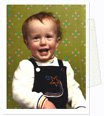
Woman on Swing, Late 1960s
The first photographer that I'd like to talk about is William Eggleston. Born and raised in Tenessee, Eggleston developed as an artist outside of the mainstream, resulting in a vision that is utterly unique. In the 1960s, when Eggleston began taking photographs, black and white photography was the accepted standard for fine art, while colour printing remained as a solely commercial process. When Eggleston's first major exhibition, "Color Photographs" debuted in New York's MOMA gallery in 1976, it ushered colour photography into a new era, one in which it was accepted as a legitimate medium in which to make fine art prints. Eggleston's work gloried in the richness and sensuality that the colour process afforded, and showcased an America that up until that point had not been noticed, at least not in 'high' culture.
Eggleston's photographs developed his principle of the 'democratic' camera, in which no scene was too mundane to look at more closely, no detail too trivial to examine. He took pictures of everything - people, landscapes, buildings - and his candid gaze seemed to enrich and illuminate the everyday. In one of his most famous pictures, The Red Ceiling, a simple and unremarkable scene is captured with a vivid candour that makes it powerful and compelling; an innocent lightbulb hanging from a ceiling suddenly seems creepy, even macabre. No one else would have taken this picture, and I think that's why I find Eggleston's work so inspiring. The singularity of his vision allows him to make images from almost nothing - looking at his pictures you start to imagine that almost nothing is off limits for closer inspection, it's just a matter of recording the scene correctly, and allowing the detail to shine through. His neutral gaze allows us to view the world anew, and reveals the splendid potential of the simplest moments. The clashing patterns of a lady in a dress on a sofa, the yellowness of a shirt, the impressive architecture of a hairdo; it all deserves our attention. Many of his pictures have people in them, but rarely are they the star of the show. Instead, you get the sense that they've wandered into frame, and become just another detail in his monumental compositions.
As well as achieving acceptance in the fine art world - he was a cohort of Andy Warhol - his work has also been used extensively in commercial contexts, largely in the music industry. The Red Ceiling was used on the cover of the Big Star album Radio City, and his work has also appeared on albums by Primal Scream, Spoon, and Jimmy Eat World. He still lives and works in Memphis.

The Red Ceiling, 1973




1 comment:
Thank you for this post, William Eggleston is amazing.
Post a Comment